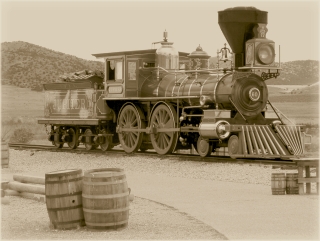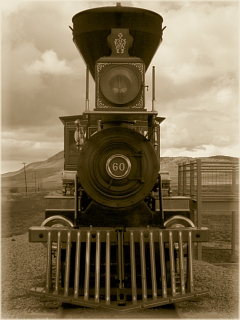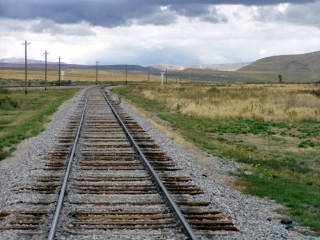NPS Website; Local Website
 WHAT IS IT?
WHAT IS IT?The location where, on May 10, 1869, the legendary Golden Spike Ceremony took place, creating the first transcontinental Railroad.
BEAUTY (4/10)
The replica locomotives are gorgeous. They are bedecked in bright, shiny colors and project an air of dignity and consequence.
The surrounding landscape is desolate and the railroad grading surprisingly steep. It still feels as if you are in the middle of the “Great American Desert”.
HISTORICAL INTEREST (9/10)
The creation of the transcontinental railroad ranks among our nation’s most important historical incidents. The railroad’s effect on growth, travel, politics, communication, time, ecology, industry, economics and life in general cannot be understated. The American West joined the East at Promontory Summit. The Golden Spike NHS is both significantly symbolic of an American era and a real place where an incredibly famous event took place.
CROWDS (3/10)
Even early Monday morning, we encountered large crowds at Golden Spike NHS. Justifiably so, given its distinct historical significance. Problem is that neither the small museum nor the short- staffed crew can handle the tourist mass. We were pushed, prodded and uncomfortable at every exhibit. Thankfully, we left just as five vanloads of visitors were arriving. Things were about to get much worse.
EASE OF USE/ACCESS (2/5)
The Golden Spike NHS is 32 miles west of Interstate 15/84 along Utah Route 83. Get off the Interstate on at Brigham City, exit 368. Do not make the same mistake we did. Coming from Logan, we decided to take Utah Route 102. The circuitous route took us through the residential neighborhoods in towns that aren’t even on the Rand McNally atlas. It took forever.
Leaving the site, we zipped along Route 83. The Site is not nearly as accessible as we imagined. Even though it is nearby the population centers of Brigham City, Ogden and greater Salt Lake City, the place where the rails connected is in the middle of nowhere. As a Golden Spike NHS pamphlet explains, “There are no gas stations, convenience stores, or repair garages within 26 miles of the park.”
 CONCESSIONS/BOOKSTORE (3/5)
CONCESSIONS/BOOKSTORE (3/5)The small bookstore had some cool stuff: O-gauge replicas of the Central Pacific Jupiter and the Union Pacific 119, golden spike shaped charms and lapel pins as well as some deliciously retro Union Pacific posters. The crowd, mostly older, was buying the stuff hand over fist. We spent over 20 minutes browsing among the throngs.
A bigger space is desperately needed. The large amount of people and money spent easily justifies more room, more stuff and a better selection of train-related books. We would also love to see some incarnation of the Railroad Tycoon computer game for sale and more trains, too.
COSTS (3/5)
Entry into the site costs $7 per car from May 1 through Labor Day (locomotive operating season) and $5 per car the remainder of the year. The Site is free with the National Parks Pass.
RANGER/GUIDE TO TOURIST RATIO (1/5)
The Golden Spike NHS suffers due to the overwhelming ratio of tourists to Rangers. Rangers stand behind a charming reconstruction of a railroad ticket counter. The information station doubles as the entrance fee collection station and triples as the gift shop checkout. Lines get long and are pushed into the already too cramped bookstore. We spent five minutes waiting for our turn so that we could ask for explanatory pamphlets.
The shell-shocked Rangers never emerged from behind the counter. We were alone in the Museum and alone outside near the replica trains. Park hours and services decrease dramatically outside of summer. From October to April, the Site is closed on Monday and Tuesday. The Golden Spike NHS Newspaper explains on its third page that seasonal volunteers are the lifeblood of the Park.
Golden Spike NHS commemorates one of American history’s most important places. It should not be forced to cope with a lack of qualified and paid Rangers.
TOURS/CLASSES (3/10)
Upon entry, we received a Golden Spike NHS newspaper that skims the surface of the Site’s enormous historical impact. Further pamphlets are available upon request. While the official Site film was a snooze-fest, five other train-related films are available for viewing upon request. We watched Thomas Edison’s The Great Train Robbery, the first motion picture.
The tiny museum tried its best, but there is just too much ground to cover in such a small space. Small exhibits explain large topics like the building of the railroad, the Chinese immigrant workers and the creation of a standard time through the pocket watch. Whole museums could be dedicated to what the Golden Spike NHS gives a few paragraphs.
From May 1 through Labor Day, the locomotive replicas are put into action. No, you cannot ride them, but you can watch. During this time, historical reenactments also take place. We came post Labor Day, met up with large crowds and enjoyed none of the fun.
The actual Golden Spike is not here. It is in a Stanford University art museum in Palo Alto, California.
 FUN (7/10)
FUN (7/10)Michael and Gab both grew up around trains. Gab’s dad has been a yardmaster practically his entire adult life. Michael’s grandfather was an engineer. The railroad is more than a means of transport, it is a massive industry spanning time zones and generations, connecting the Oceans, encouraging Manifest Destiny and uniting the goods and cultures of both coasts into a sort of American collective. The small piece of track at Promontory made all of that possible.
This site had a lot of meaning for us. We were thrilled to be at such a historic place. But we grew weary of trying to gather everything we could from small interpretive panels that were already crowded by railroad enthusiasts also trying to milk all the information they could from the meager displays. This Visitors Center should be as large and as grand as Mount Rushmore’s. Even then, it still might not have enough room to adequately address the cultural significance of the transcontinental railroad and the innovations and issues it created for America.
Despite all of that, we still ran out to the shiny engines, felt their steam, peered into their cabs, smelled the familiar tar and wood of the railroad ties. We requested a showing of The Great Train Robbery and were amazed at its ingenuity, as was the audience that gathered as it played. Gab was ready to watch the 30-minute Charlie Brown cartoon on the railroad, but that somehow got vetoed by Michael.
WOULD WE RECOMMEND? (7/10)
We came to the Site with high expectations and excited enthusiasm. We love trains. We left disappointed by the Federal disregard of an American icon.
TOTAL 42/80
www.usa-c2c.com
© 2004-06